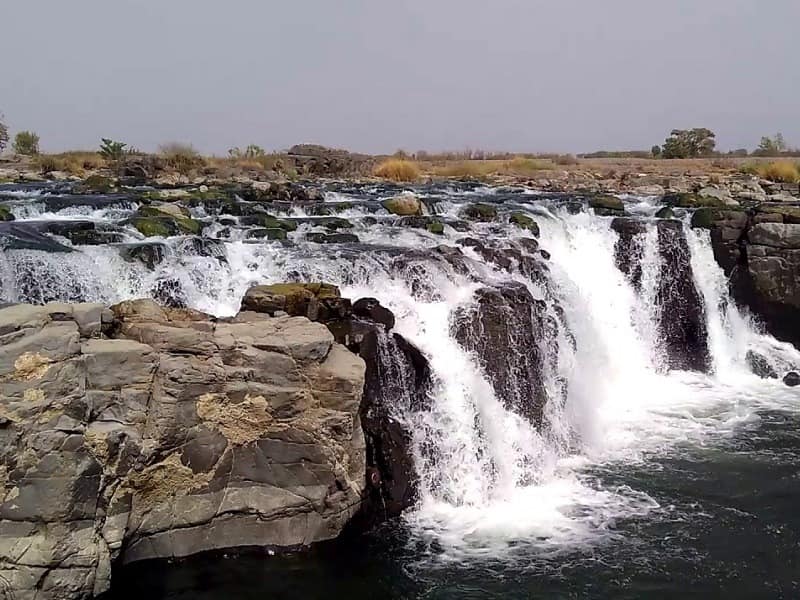
As one goes slightly downstream of Maheshwar, there is another place called Sahsra-dhara (first being near Mandla) where we again come across the phenomenon seen in the first Sahsradhara – of Narmada splitting into numerous streams and falling, before getting united after some distance.
How Sahasradhara came into being has a very interesting legend. Ravana, it seems, was engrossed in the worship of Shiva. His worship was disturbed by Kartavirya Arjuna, also known as Sahasrabahu (the thousand-armed one) when the latter, bathing with his several consorts, playfully tried to stop Narmada with his thousand arms, but Narmada still forged ahead in a thousand streams (as a result of diversion due to Sahasrabahu’s arms, giving the spot its name. A furious Ravana, whose flowers of worship had all got swept away in the new streams that flowed, stormed to Kartavirya but was no match for him. Kartavirya made him his prisoner. It was only at the behest of Ravana’s grandfather, the venerated sage Pulatsya, that Kartavirya released Ravana.
That there is a place called Sahasradhara both near Mandla and Maheshwar, has in no small measure, added to the confusion regarding Mahishmati, the place referred to in Pauranik literature. People in Mandla claim their town as Mahishmati but the larger opinion in Narmadakhand backs Maheshwar’s claim. Highly regarded Sanskrit scholar Dr Ayodhya Prasad Dwivedi, an authority on Kalidas as well as Narmada, in his supremely scholarly work ‘Narmada- Sanskriti Srotisvini’ deals with this question in great detail. There have been scholars who have even forwarded the idea that Omkareshwar was the Pauranic Mahishmati with some good arguments but that opinion has not had much foothold in people’s imagination.
Some distance downstream of Maheshwar, which is located in Khargone district, Narmada forms a boundary between Dhar district on the northern banks and Khargone district on south. A few miles downstream of Maheshwar is located Khalghat, where the bridge on the major National Highway (the Agra-Bombay Road) takes one to the southern banks of Narmada. A sort of industrial complex has also come in the region and as result that area has become quite congested. At Khalghat is also the Sathak Sangam.
The Parmars of Dhar
The Parmars ruling out of Dhar – then called Dharanagari, a town 60 km south-west of Indore, held control over parts of the Narmadakhand for a certain length of time. In particular, the Parmar ruler Sindhuraj had his kingdom spread across a considerable part of Narmadakhand. During his time, the poet Parimal Gupta, also referred to as Padma Gupta, wrote his noted and much acclaimed work ‘Navsahasank Charit,’ a work of artistic imagination mixing facts and fantasy, replete with evocative descriptions of Narmada.
Sindhurja seems to be quite a capable ruler but the most famous Parmar ruler was Sindhuraj’s son Bhoj who in addition to his high abilities in statecraft, was also a scholar of no mean achievement, and authored a large number of books. He created a great place of Sanskrit learning in Dhar called the Bhojshala. Unfortunately the place (now under Archaeological Survey of India) has been a witness to communal tension of late on account of competing claims of the Muslims and Hindus. It is used as a mosque and a temple with a neat though rather unusual plan to avoid any conflicts. On Tuesdays only Hindus are allowed while on Fridays only the Muslims. On other days it is open to all for visit with a modest entry fee of one rupee (perhaps lowest anywhere in India, except where toally free.) There is a Saraswati idol in Bhojshala precincts and the Hindus also observe the Saraswati Puja on the Vasanta Panchami Day. When the Vasanta Panchami falls on a Friday then the situation becomes tensed with chances of a communal flare up, and administration has a tough task on their hands.
Raja Bhoj also constructed many temples elsewhere in his territory, including the famous Bhojeshwara Shiva temple at the village of Bhojpur on the banks of the river Betwa, about 27 km from Bhopal. He is credited to have constructed several dams and one of the largest man-made lakes in the country – the upper lake (locally called the ‘Bada Talaab’) of Bhopal, earlier called Bhojtal. Bhopal, itself, it is said, gets its name from Bhoj, probably derived from Bhojpal (being nurtured by Bhoj.) The airport at Bhopal is named after Raja Bhoj.
About six miles downstream of Khalghat, in the district of Dhar only, is the village of Dharampuri. The southern banks at that place are in Barwani district, which was a major hotspot of the ‘Narmada Bachao Andolan’ highlighting the issue of human displacement and resettlement, not seen on a similar scale before – the Chipko Movement of Tehri Garhwal had environment as its primary focus – but the NBA focussed more on people.

Just in front of Dharampuri is a beautiful forested island having a Shiva temple and many other smaller shrines in the complex. It is called the ‘Bilwamriteshwar Mahadev’ and one can reach there through boats from both the banks – Dhar district in the north and Barwani on the south. The Parkammavasis cannot visit it as per the conventions. It is said that the great king Rantideva, a descendant of King Bharat and belonging to the Suryavansha (the solar dynasty) and who was known for his great selflessness and generosity, had performed Tapasya here. Srimad Bhagwatam says that Rantideva was tested by the Devas for his much-acclaimed generosity which they thought would crumble in face of great hardships he and his family were made to undergo. But Rantidev passed all difficult tests and became known as the epitome of selflessness and generosity. Acharya Sankara also honours Rantideva in the ‘Narmadashtakam’ stotra.
Dharampuri is also said to be the Taposthali (place of spiritual disciplines) of Rishi Dadhichi. His name is highly honoured in the Pauranic literature for giving his bones to make weapons for the Devas in their battle against the Asuras. Sister Nivedita has written beautifully about this when she proposed Vajra as a National Emblem :
The gods, it is said, were looking for the divine weapon par excellence – and they were told that only if they could find a man willing to give his own bones for the substance of it, could the Invincible Sword be forged. Whereupon they trooped up to the rishi Dadhichi and asked for his bones for the purpose. The request sounded like a mockery. A man would give all but his own life-breath, assuredly, for a great end, but who, even to furnish forth a weapon for Indra, would hand over his body itself? To the rishi Dadhichi, however, this was no insuperable height of sacrifice. Smilingly he listened, smilingly he answered, and in that very moment laid himself down to die – yielding at a word the very utmost demanded of humanity.
Here then, we have the significance of the Vajra. The Selfless Man is the Thunderbolt. Let us strive only for selflessness, and we become weapon in the hands of God. Not for us to ask how. Not for us to plan methods. For us, it is only to lay ourselves down at the altar-foot. God does the rest. The divine carries us. It is not the thunderbolt that is invincible but the hand that hurls it. Mother! Mother! take away from us this self! Let not fame or gain or pleasure have dominion over us! Be Though the sunlight, we the dew dissolving in its heat.
Dharmapuri has a substantial Muslim population and the local Muslims are second to none in their reverence for ‘Narmada Maiyya.’ There are Muslims who do ‘Mannat’ (wish-seeking) on the banks, offering coconuts etc. They are also most cooperative to the Parikramavasis in any ways possible. These stories in the Narmada region, and one might say, in so many different parts of India, really await proper recounting by some enterprising writer or better still, a film-maker. Dharmapuri was the native place of Rupmati, the legendary queen of Mandavgarh, a great songstress, and a great devotee of Narmada. It is said that since she could not imagine living without the ‘Darshan’ of her adorable Narmada, the latter appeared in form of a spring at the forted town of Mandavgarh or Mandu, high on the Malwa plateau, about 30 km from Dharampuri. This is called the ‘Reva Kund’ and is usually visited by Parikramasis, even though causing sort of a detour, and a challenging one at that.
Mandu – Overlooking the Narmada
Mandavgarh or Mandu is an archaeological splendour in itself with numerous places like the Jahaj Mahal, Hindola Mahal, the tomb of Hoshangshah, and the Rupmati’s pavilion (which gives a splendid view of the Narmada plains below) and temples like the Chaturbhuja Rama temple, the vigraha (idol) of which is said to be 1100 years old, and the Neelkanth Mahadev temple for which one has to climb down quite a few stairs.
Mandu has had a long and chequered history. It had been an important outpost of the Pratihar rulers. As already mentioned, Raja Bhoj u his capital in the town of Dhar, which is about 35 km from Mandu. Inscriptions indicate that Mandu was called Mandapdurg in those and even earlier days around the times of Harshavardhan. The strategic benefits Mandu offered were not lost to the attention of royals and satraps of the region. The later Parmar rulers found Mandu to be ideal as a fort town that could potentially serve as a bullwork against threats from surrounding areas, notably from Vaghelas of Gujarat, and thus highly significant in controlling the Malwa region. The citadel of Mandu developed with a 37 km wall at the periphery with several gates. The Parmars were said to have built many Shiva temples and some cave-temples too, probably for ascetics. The Parmars were overthrown by Alauddin Khilji of the Delhi Sultanate in 1305 who placed his lieutenant Ayn al Mulk Multani in charge of Mandu, and the whole of Malwa region. Then began the period of Afghan dominance in the region.
The Delhi Sultanate controlled it for nearly a century but it was facing its own set of problems with Timur creating havoc in northern India. The Khiljis themselves had been replaced by the Tughlaqs at Delhi. As a result of this, their representative in charge of Malwa region (and Mandu) Dilawar Ghuri declared himself a sovereign of the region in the year 1398. He named Mandu as ‘Shadiyabad’ – the city of joy.
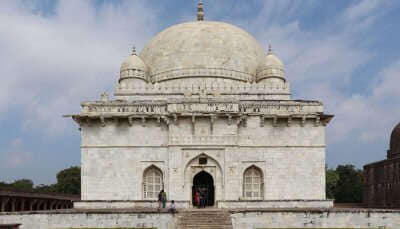
But it was Dilawar Ghuri’s son Hoshang Shah, who having ruled for a period of 27 years from 1405 to 1432, came to have a significant impress on the archaeological development of Mandu. Hohshang Shah built several significant monuments like the Jama Masjid, modelled on the great mosque of Damascus, and his own tomb ‘Hoshang Shah ka Maqbara,’ though unfortunately he himself met his end at Narmadapuram and that was where he had his final resting place. His tomb at Narmadapuram gave the town the name Hoshangabad, recently reverted to Narmadapuram. History enjoys its little ironies. Afghan architecture is present very markedly in Mandu. The Hoshang Shah’s tomb, it is supposed, later influenced the design of Humayun’s tomb, which in turn lent some of its features to the Taj Mahal.

Hoshang Shah’s son ascended to the throne in 1432, but was assassinated by Mahmud Shah, who then took the name of Mahmud Khilji. This Sultan was interested in education and created a Madrasa – Asharfi Mahal – that housed scholars in a very tiny rooms, only big enough to stretch oneself. Probably, the idea of austerity was ingrained in Islamic system of education as practiced by this Sultan. Mahmud Khilji also built a quite well-planned hospital with competent physicians in charge of it. It had several wards and along with Asharfi Mahal is an indicator of welfare interests of this Sultan. Though he had got his predecessor assassinated, Mahmud Khilji apparently did not bear any malice towards the former, as evident in his act of overseeing the competition of unfinished ‘Hoshang Shah ka Maqbara’ as well as the ambitious project of Jama Masjid. Mahmud Khilji ruled for thirty-six years and had a considerable influence on subaequent development of Mandu.
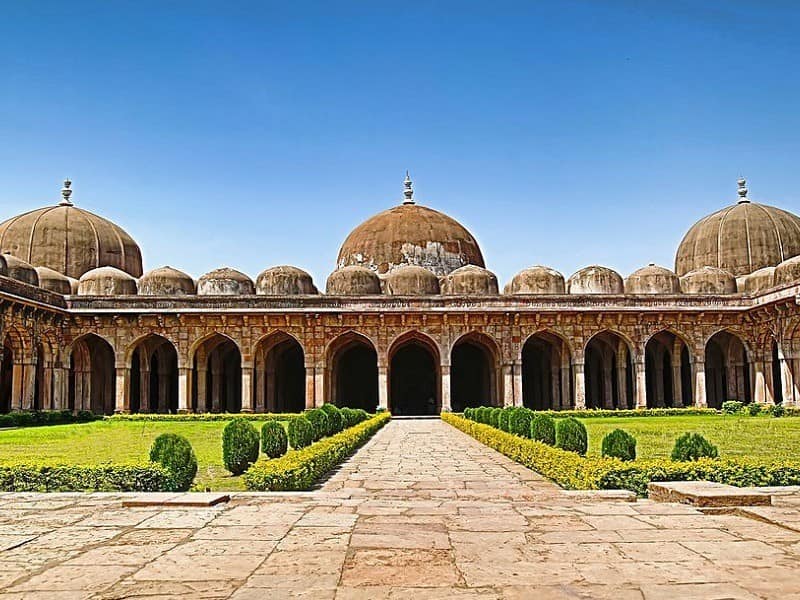
Another marked development in Mandu’s structures was in the field of water supply based on sound scientific principles. That is most evident in Jahaj Mahal group of structures like the ‘Hamam’ and ‘Champa ki Bawri.’
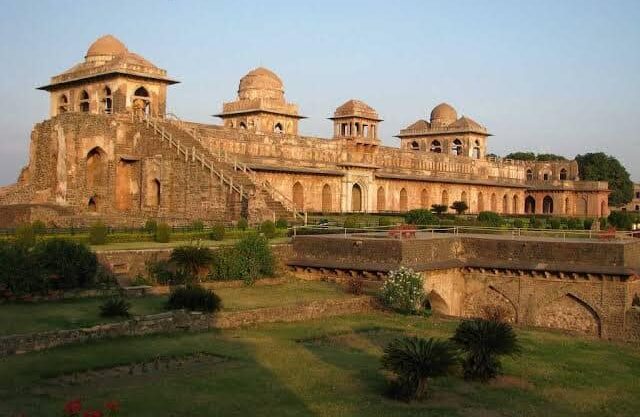
Mahmud Khilji’s son was Ghiyasuddin Khilji. He reigned for thirty years till 1500. He constructed the Jahaj Mahal, it was a place for housing a very large number of women of diverse skills like wrestlers, dancers and entertainers from all over the subcontinent and even outside. It is very often referred to as a harem, implying that the women there were merely captive concubines. This might be partially true but one feels that it is a bit unkind judgment, as efforts to educate and further the skills of these women too were undertaken. The Jahaj Mahal complex is said to have consisted of as may as twelve thousand such women inmates. The Jahaj Mahal is perhaps the signature structure of Mandu. In rainy season it is surrounded by water and bears an appearance of a sailing ship. The Hindola Mahal (literally meaning the ‘swinging palace’) served as the Sultan’s court.
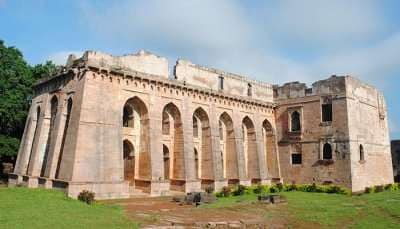
The Malwa cuisine also got developed with great sophistication during Ghiyasuddin’s time and some manuscripts of the recipes are in possession of the British Museum. The following decades marked by intrigues of power saw considerable turmoil in the Malwa region with a number of transfers of power for short periods. The Gujarat Sultan also had its eyes upon it with the collusion of the Portuguese, who had in the sixteenth century, solidly established themselves as a significant player on the Arabian sea coast. Mandu was later won, albeit for a short while, by Humayun, and subsequently by Sher Shah Suri. Sher Shah had appointed one Shuja Khan as his governor for Malwa. Sher Shah’s nobleman Hemu (who fought Akbar in the second battle of Panipath) also briefly held a sway of influence in the region.
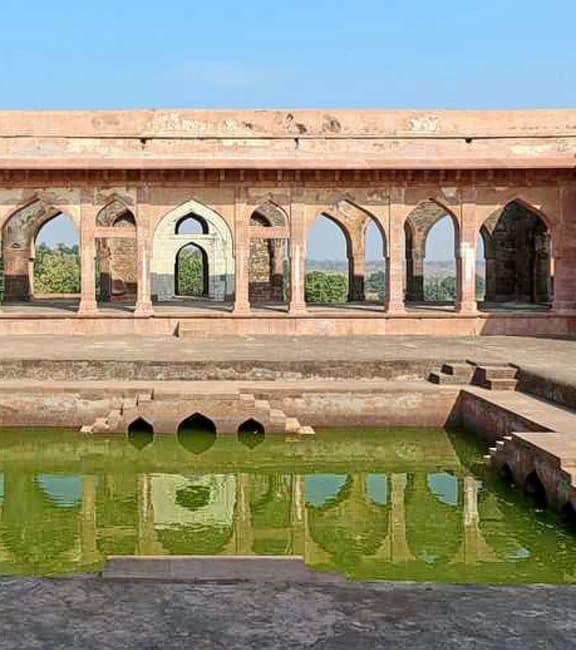
But it was Shuja Khan’s son, Baz Bahadur, who was the last illustrious name in annals of Mandu despite his relatively short rule of eleven years, from 1551 to 1562. He gave a huge boost to the architectural splendour of Mandu, erecting very significant and sophisticated monuments like Baz Bahadur’s palace, which with its acoustic provisions was a great place for musical soirees. He built or perhaps further developed one of the finest monuments in Mandu, the ‘Rupmati ka Jharokha’ (Rupmati’s pavilion) at one end of the hilltop. Made of sandstone this splendid monument offers on a fine day, a view of the Narmada flowing some ten miles below on the south from its watchtowers.
Baz Bahadur lost to Akbar’s forces in 1562. It is said that Rupmati then chose to end her life, while Baz Bahadur, after remaining fugitive for several years, finally joined the Mughal service. Among the Mughal emperors Jehangir was particularly fond of Mandu. He had once stayed there for seven months and is reported to have said that there was hardly any place he knew of that matched the beauty and pleasant climate of Mandu during the months of the rainy season. Shah Jehan too is said to have visited the place.
Mandu was finally taken by the Marathas under the leadership of Bajirao Peshwa I in 1732. He installed his associates Puwar in charge of Mandu. The Puwars later developed the ‘Chaturbhuja Rama Mandir,’ the idol of which is said to have existed from the later part of the first millennium.
Independent India has also attracted several luminaries to savour the splendours of Mandu. Jawaharlal Nehru, with his characteristic fascination for history, visited Mandu and even stayed overnight. One feels that now in these days of vacationing in exotic places, often abroad, that the Indian upper classes have greater proclivity of taking to, places like Mandu are no longer on the first tier of tourism circuit in India.
▶Next Chapter: In the Bhil country – Alirajpur, Barwani, Shoolpani Jhadi and the story of Baleshwar Dayal